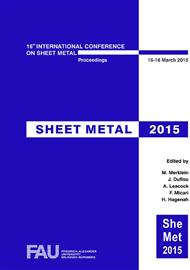p.377
p.385
p.395
p.403
p.411
p.419
p.427
p.435
p.443
A Constitutive Model for the Simulation of the Deformation Behavior of TWIP Steels
Abstract:
Due to their high strength (tensile strength > 1GPa) in combination with an extreme ductility (failure strain 30-50%) TWinning Induced Plasticity–steels (TWIP-steels) can be considered as promising materials for the production of lightweight automotive components. The industrial application of TWIP-steels requires a fundamental experimental validation of the mechanical behavior as basis for an user-friendly but at the same time accurate constitutive framework and its implementation into commercial Finite Element codes. Related investigations and implementations in order to allow for the simulation of TWIP-steel forming processes are currently conducted within the research project “TWIP4EU”, executed as a cooperation of Fraunhofer - Institut für Werkstoffmechanik IWM in Freiburg (Germany), Salzgitter Mannesmann Forschung GmbH (Germany), Swerea KIMAB (Sweden), Faurecia Autositze GmbH (Germany / France), DYNAmore GmbH (Germany) and ESI GmbH Engineering System (Germany / France).The monotonic one-dimensional hardening behavior of TWIP-steels as a function of the twin volume fraction and dislocation density has been described by Bouaziz et al. (2008), Bouaziz et al. (2011). This model has been proven to be adequate for the description of the flow behavior of TWIP-steels and serves as basis for the constitutive model, presented here. This Bouaziz-model has been extended to a three-dimensional elasto-plastic formulation, including the influence of different loading conditions, anisotropy and kinematic hardening. The present paper deals with the implementation for solids and shells in the commercial Finite Element Code LS-DYNA® and appropriate validation simulations will be presented.
Info:
Periodical:
Pages:
411-418
Citation:
Online since:
March 2015
Authors:
Keywords:
Price:
Сopyright:
© 2015 Trans Tech Publications Ltd. All Rights Reserved
Share:
Citation:


